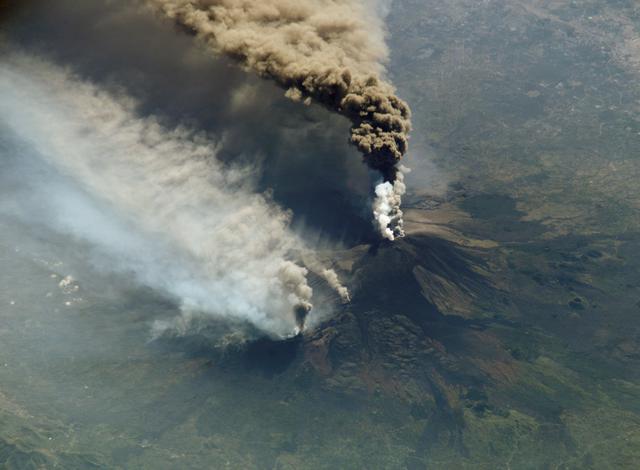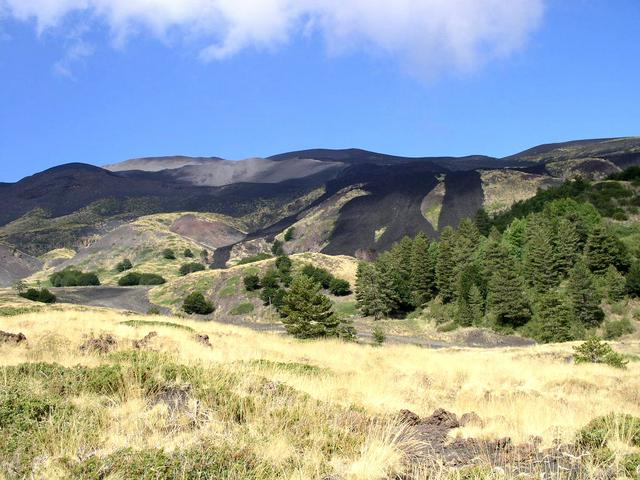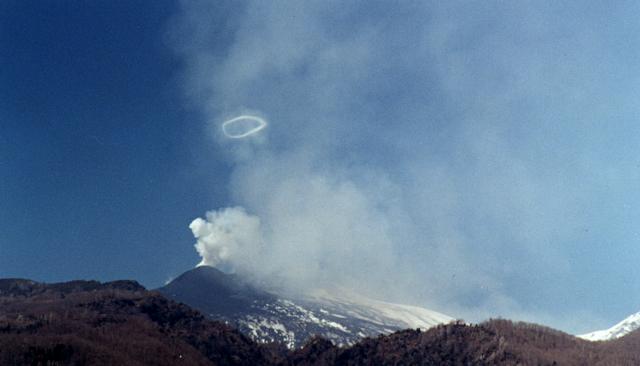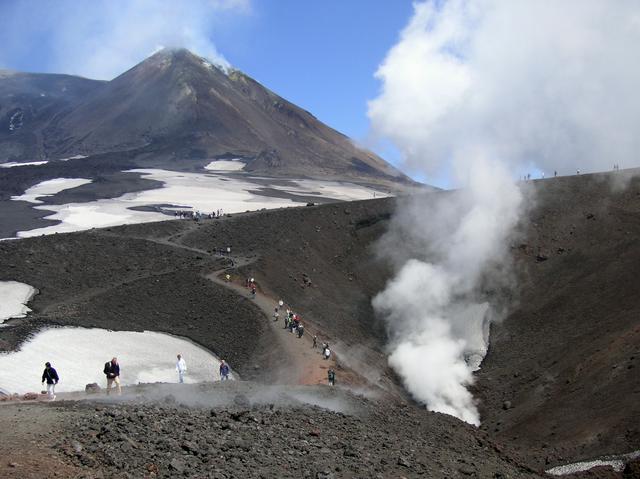Mount Etna is a 3329-m-high active volcano in Sicily, Italy. It's on the east coast, just north of the city of Catania.


Mount Etna is here because the tectonic plate of Europe (carrying mainland Italy and Sicily) is colliding with and overriding the African plate. The African plate is peeling away from the surface and descending deep into the earth, where water in porous rock and hydrated minerals is forced out. This causes the overlying (European) rock to melt and rise, until it collects in a pool of magma near the surface. The drop in pressure enables gas to bubble out of the magma, until the mixture of gas and magma eventually erupts through the surface. This has been happening continually on Mount Etna for some 500,000 years, with multiple layers of lava and ash building up into a mighty stratovolcano.
Mount Etna has been more active since the start of the 20th century, and even more so in the 21st. Its height is about 3329 m or 10,922 feet (as of 2007), but it's constantly being remodelled by eruptions from the five summit craters. These are usually spectacular but only destructive to the immediate vicinity. But there also dozens of side-vents lower down the flanks of the mountain, which sometimes erupt close to human habitation.
Reluctance to settle too near has preserved the natural wildlife and habitat, ranging over several climate zones. The whole area is a Nature Reserve, and is inscribed on the UNESCO World Heritage List. The area is a ski resort in winter. Come dressed for the cold even in summer.
There are two access routes to the summit. The south side is the usual route, via Rifugio Giovanni Sapienza. at 1923 m. This can be reached by 3 public roads: from the village of Nicolosi by either the SP 92 or the "Via Catania"; or from the village of Zafferana further northeast, also by the SP 92. A cable-car continues from Rifugio Sapienza to within 800 m of the summit.
The east side access is less touristy but more challenging, via Piano Provenzana. at 1800 m. This is reached by the public road that loops up from Fornazzo and from Linguaglossa. And then you've got a long hike ahead of you. This area is even more starkly volcanic than Sapienza, as it was engulfed in the eruption of 2002.
The two approaches are separated by the deep, forested Valle del Bove (Valley of the Ox): this is where the side of the mountain collapsed and slid into the sea circa 6000 BCE, causing a huge tsunami. Etna's fury is usually directed onto its eastern flank. The western side is spared, and several farming villages have long been here, such as Bronte and Maletto. They're worth a look but there are no practical routes up the mountain from the west side: it would involve a two- or three-day expedition.
Many companies offer tours and activities on Mount Etna, with day-trips from Catania, Taormina and elsewhere. These cost more than independent travel but make the logistics so much easier. Book them online in advance. If you arrive without fixing anything, enquire at the Park Headquarters, Parco dell’Etna, Monastero di San Nicolò La Rena - Via del Convento, 45 - 95030 Nicolosi (CT), +39 095 821111.
There are two access routes to the summit. The south side is the usual route, via Rifugio Giovanni Sapienza. at 1923 m. This can be reached by 3 public roads: from the village of Nicolosi by either the SP 92 or the "Via Catania"; or from the village of Zafferana further northeast, also by the SP 92. A cable-car continues from Rifugio Sapienza to within 800 m of the summit.
The east side access is less touristy but more challenging, via Piano Provenzana. at 1800 m. This is reached by the public road that loops up from Fornazzo and from Linguaglossa. And then you've got a long hike ahead of you. This area is even more starkly volcanic than Sapienza, as it was engulfed in the eruption of 2002.
Many companies offer tours and activities on Mount Etna, with day-trips from Catania, Taormina and elsewhere. These cost more than independent travel but make the logistics so much easier. Book them online in advance. If you arrive without fixing anything, enquire at the Park Headquarters, Parco dell’Etna, Monastero di San Nicolò La Rena - Via del Convento, 45 - 95030 Nicolosi (CT), +39 095 821111.

You've come all this way, you've got to see the smouldering cratered landscape of the summit. This is starkly black, as vegetation hasn't had time to take hold after recent eruptions. Except when it's starkly white, as snow lies late here, or dismal grey because the clouds and rain have closed in.
The ascent is relatively easy, weather permitting. First take the cable car up to 2604 m. This is met by off-road 4WD buses which scramble up a pumice track to the summit vantage point of Torre del Filosopho. (If the cable-car isn't running, these buses start from Sapienza.) The cable car costs €20, but there isn't much to see at the cable car's terminus. The car of cable car, 4WD bus and guide is €65 (Oct 2019). Buy your tickets in the white Funivia building at the base of the cable car.
There are also many offices selling excursions, which include 4-5 hour guided hikes to the crater, mountain bike trips, and ATV trips.
You will find restaurant, souvenir shops, honey and wine sellers. There is also a "7-D" movie experience about Etna's eruptions at the base of the cable car (€7, Oct 2019), but who knows what "7-D" means.
Hiking is the only option: see "Do".

- Hiking: you must have a guide to hike the upper slopes. Regular guided hikes set out out from Sapienza and from Provenzana, conditions permitting. You must be fit, hardy and well-dressed against cold wind and sleet, and for some winter treks you need an ice-axe, but you don't need specialist rock-climbing skills or equipment. Rival guide teams Gruppo Guide Alpine Etna Sud and Gruppo Guide Etna Nord work from both bases.
- From Sapienza these use the cable car and 4WD buses to reach the summit area, before striding off on a 4-5 hour trek of the charred terrain.
- From Provenzana the standard treks are just 2-3 hours, as the 2002 eruption came so close here.
- Skiing in winter from the two base stations.
- Etna South, above Sapienza, has 6.3 km of piste from 1910 to 2604 m altitude, with one gondola, one chairlift, and 3 towbars.
- Etna North, above Provenzana, has 10.3 km of piste from 1810 to 2336 m altitude, with one chairlift and 3 towbars. The two areas are not linked. The season is fairly short as these are low altitudes by Alpine standards.
- The excursion centre next to Sapienza cable-car also offers ski-touring, off-road cycling and quad biking according to season.
- There's donkey-trekking at Provenzana.
Hiking: you must have a guide to hike the upper slopes. Regular guided hikes set out out from Sapienza and from Provenzana, conditions permitting. You must be fit, hardy and well-dressed against cold wind and sleet, and for some winter treks you need an ice-axe, but you don't need specialist rock-climbing skills or equipment. Rival guide teams Gruppo Guide Alpine Etna Sud and Gruppo Guide Etna Nord work from both bases.
- From Sapienza these use the cable car and 4WD buses to reach the summit area, before striding off on a 4-5 hour trek of the charred terrain.
- From Provenzana the standard treks are just 2-3 hours, as the 2002 eruption came so close here.
Skiing in winter from the two base stations.
- Etna South, above Sapienza, has 6.3 km of piste from 1910 to 2604 m altitude, with one gondola, one chairlift, and 3 towbars.
- Etna North, above Provenzana, has 10.3 km of piste from 1810 to 2336 m altitude, with one chairlift and 3 towbars. The two areas are not linked. The season is fairly short as these are low altitudes by Alpine standards.
There are lots of souvenir shops around Rifugio Sapienza.
Cafes and restaurants around Rifugio Sapienza include La Terrazza, Monte Gebel, Silvestri, and the two hotel restaurants. Provenzana has Ristorante Monte Conca.
Bar Etna is at the top cable-car station above Sapienza. It's by some distance the highest bar in Sicily, and has Alpine prices of course, but in the bitter cold you might be grateful for that hot chocolate. "Fuoco dell'Etna" is a liqueur which will definitely make you feel warm, but save it till after the summit ascent.
Onward travel will probably be via Catania, see that page for suggestions.
